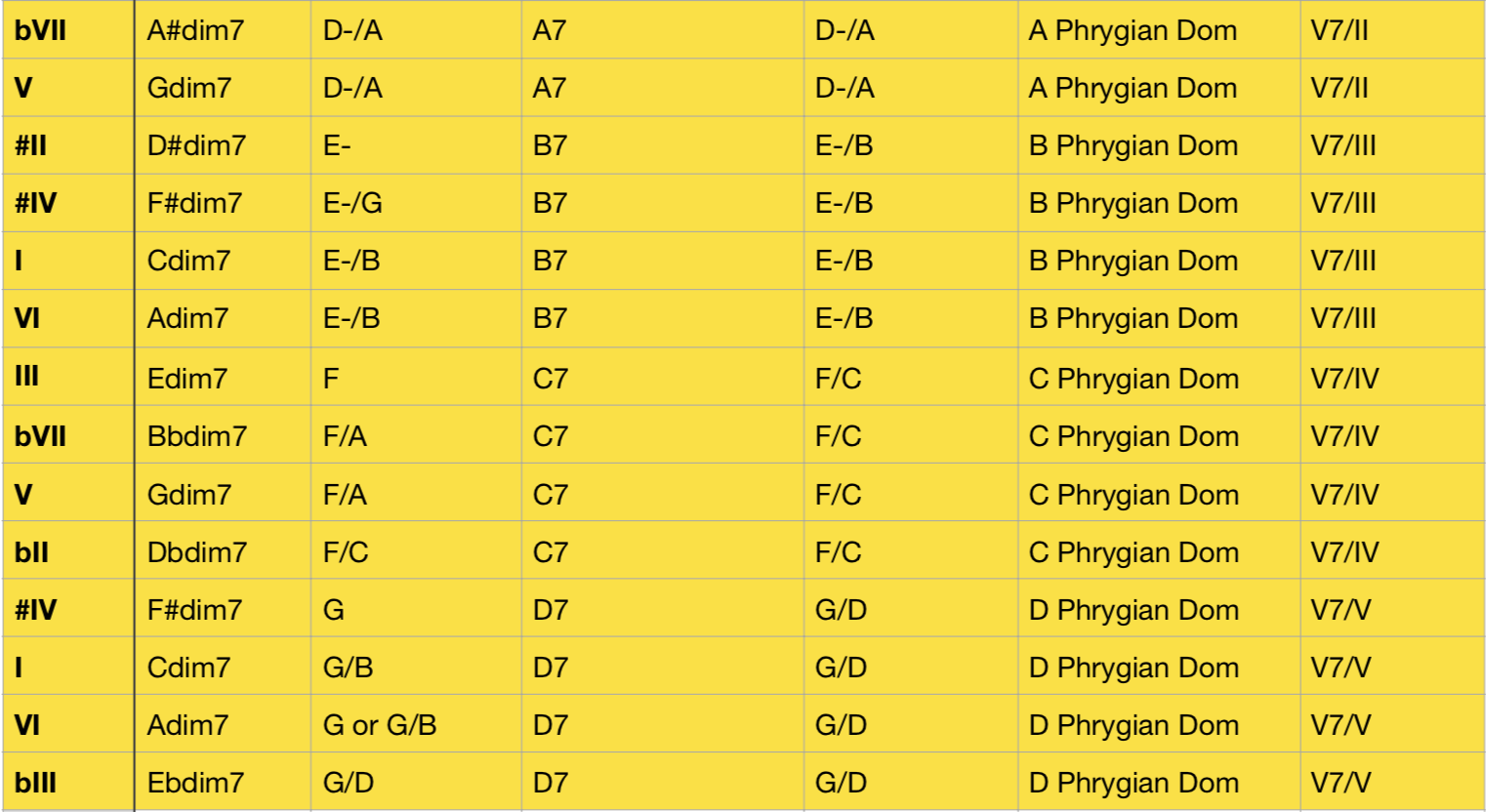This lesson is a little heavy on the theory, but there is a cheat sheet at the end!
For the longest time I couldn’t for the life of me figure out what was going on with Diminished 7th chords. Where did they come from? What were they doing harmonically? What scale should I play over them? Could I add extensions to them? I couldn’t find any good literature on the matter. So in the end myself & my good friend Dan Dotor put our heads together in an attempt to figure it out.
What we discovered is that not all Diminished 7th Chords are created equal. You have to do a little detective work to figure out what you’re dealing with.
Diminished 7th chords fall into one of 3 groups:
Idim7 and all of its inversions - Idim7, bIIIdim7, bVdim7, VIdim7
Rootless inversions of V7b9
Rootless inversions of secondary dominant chords
Now at this point you might be thinking ‘What the fuck is he talking about'?’. So I’ll endeavour to explain these one at a time and then provide you with a table that includes all of the diminished 7th chords that you could use to resolve to chords in the key of C. You can then transpose as necessary. All examples are in C major.
Idim7 & all of its inversions:
Idim7 is huge! Nobody ever talks about it….. Idim7 is basically Cdim7 resolving back up to C. This could be C, C6, Cmaj7, C7, C-7 etc but for now we’ll just look at C.
Cdim7 consists of C, Eb, Gb, A. The Eb and the Gb resolve upwards by a semitone each to E & G - the 3rd & 5th of C. You can either keep the A to make C6 or resolve it to G or C but these resolutions aren’t so strong as they’re not semitone resolutions.
Because diminished 7th chords are symmetrical - built on stacked b3rds, every diminished 7th chord is actually 3 other diminished 7th chords. So when examining Idim7 we see that it’s also bIIIdim7, bVdim7 & VIdim7 - they all contain the same 4 notes. As such they all resolve back to I. The best way of applying this is to use them to resolve to inversions of I.
Let me explain:
Idim7 - I: Cdim7 - C6
bIIIdim7 - I: Ebdim7 - C/E
bVdim7 - I: Gbdim7 - C/G
VIdim7 - I: Adim7 - C/G.
These are all Idim7-I.
The scale you’d use to improvise over Idim7 is the Whole Half Diminished scale. This scale goes up a whole tone then a semitone until it reaches the root again. This essentially yields a major scale with all of the chord tones of C major replaced by C diminished: C D Eb F Gb Ab A B C. The only exception here is the Ab (b6/#5). We still retain our 2,4,6 from the major scale. So we can use these as extensions if we like.
Anytime you see Idim7 - I or any of its inversions. Play Whole Half Diminished over it.
A very common example of this is when you see F#dim7 or Gbdim7 resolving to C/G in bar 6 of a blues. This is Idim7-I and you should play Whole Half Diminished over it. Try it out!
Idim7 - I is a very strong tension - resolution. It’s arguably as strong as V7-I.
Rootless inversions of V7b9:
Contained in our Whole Half Diminished scale are the notes Ab, B, D, F. These are the notes of G7b9 (omitting the G). G7 is the V7 of C. So whenever we play either Abdim7, Bdim7, Ddim7 or Fdim7 we are playing G7b9 and because of this all 4 of these dim7 resolve back to C. I would however play G Phrygian Dominant over these 4 dim7 chords. The reason for this is that G7b9 is found organically in the C Harmonic minor scale and actually contains the note of G and no natural 9 (A). It’s more consonant over G7b9 than the Whole Half Diminished scale.
I use Whole Half Diminished scale over Idim7 and Phrygian Dominant scale over V7b9.
Rootless inversions of secondary dominant chords
Any dim7 chord can be seen as a disguised (rootless) 7b9 chord as was the case above. Not only that but it can be four separate 7b9 chords.
Abdim7 is G7b9 (Ab,B,D,F). It is also E7b9 (F, G#, B, D) Db7b9 (D,F,Ab,B) Bb7b9 (B,D,F,Ab). None of these 4 chords have their root note in them but have b9s in its place. Only two of them pull to diatonic chords. G7b9 pulls to C and E7b9 pulls to A-. So Abdim7, Bdim7, Ddim7 & Fdim7 can be used as G7b9 resolving to C but also as E7b9 resolving to A-. This is a Secondary Dominant.
A Secondary Dominant is a chord that is not normally a dominant chord diatonically but which has been turned into a dominant to create a stronger pull to the diatonic chord of which it is the V.
In the example above I used E7b9 - A-. In the key of C III would normally be E-7 but if we raise the 3rd (G-G#) we create a stronger pull to A via semitone motion instead of tone motion. This creates the secondary dominant E7. So G#dim7 to A-7 is actually E7b9 to A-7 as is all of its inversions. Again you would use the Phrygian Dominant Scale to play over these chords as they’re all 7b9 chords.
You can create a secondary dominant to pull to every diatonic chord except the VII as this is a m7b5 chord and inherently unstable.
Here is a quick secondary dominant cheat sheet.
VI7 pulls to II-
A7 to D-VII7 pulls to III-
B7 to E-I7 pulls to IV
C7 to FII7 pulls to V
D7 to GIII7 pulls to VI-
E7 to A-
Each of these Secondary Dominants can be disguised as 4 dim7 chords. So as an example B7 to E- could be Cdim7 to E-/B, D#dim7 to E-, F#dim7 to E-/G or Adim7 to E-/B.
Take a breather & then recap.
With so many possibilities for resolutions with dim7 you may be wondering ‘How do I determine which dim7 is which?’. The answer is that you need to look at where your dim7 is resolving to. For example if Ebdim7 is resolving to E- then it is B7b9 V7/III (to E-). However if Ebdim7 is resolving to C/E then it is Idim7. Both would take different scales as discussed.
No wonder it was so confusing!
One last little nugget for you if you’re still with me…… Idim7 & its inversions have not been derived from dominant chords as all other dim7 chords have. This does not mean however that you can’t derive dominant chords from Idim7. You can. Four in fact! If you look at Idim7 as four 7b9 chords and then lower the b9s it yields:
B7 - B, D#, F# A from C, Eb/D#, Gb/F#, A
D7 - D, F#, A, C from Eb, Gb/F#, A, C
F7 - F, A, C, Eb from Gb, A, C, Eb
Ab7 - Ab, C, Eb, Gb from A, C, Eb, Gb
All of these 4 dominant chords will resolve to C in the same way that Cdim7 does. As such you would play C Whole Half Diminished over them and can use b9, #9, #11 and 13 as extensions on the chord. These sound most strong with good voice leading.
Here is a table showing all of the ways that you can resolve to diatonic chords in the key of C with dim7 chords. It’s best to use it by searching for the chord you’d like to resolve to and then looking at which options you have available to you. I’ve colour coded it as per the 3 groups of Diminished 7th chords.
Red = Idim7 and its inversions
Blue = Rootless inversions of V7b9
Yellow = Rootless inversions of Secondary Dominant Chords.
Try experimenting with interesting dim7 resolutions. For example if you’re going from C to A-, put a Bdim7 in front of the A-. Or you could play C - Ddim7 - A-/E. In both of these cases the dim7 represents a disguised (rootless) E7b9 chord.
I hope you’ve enjoyed this lesson. Do contact me if you have any questions.
All of these resources are made for free and they do take considerable time & effort.
If you are enjoying them & finding them to be useful then please do consider donating (no matter how little) or sharing them on social media as a means of support.
Thanks so much, James.


